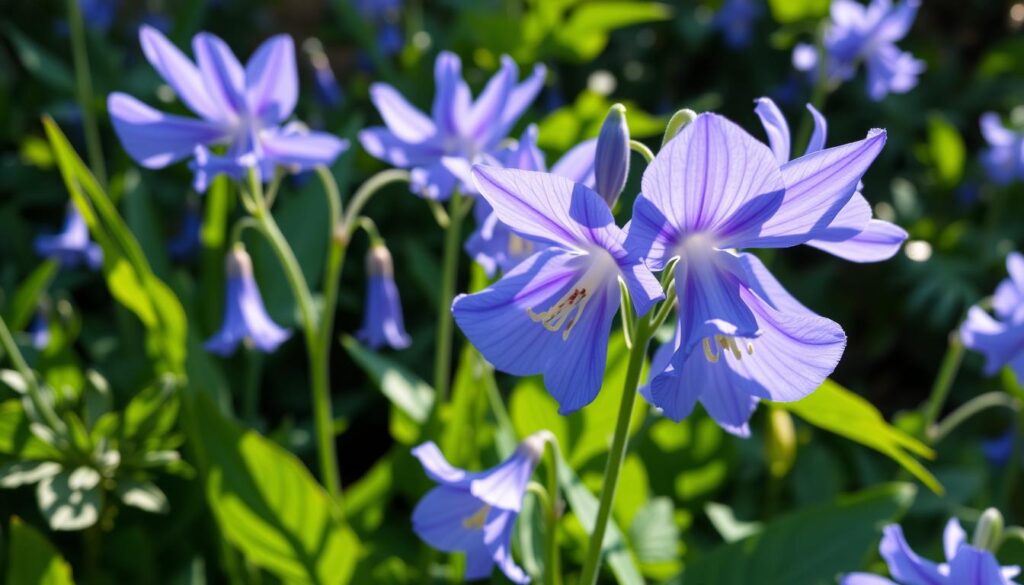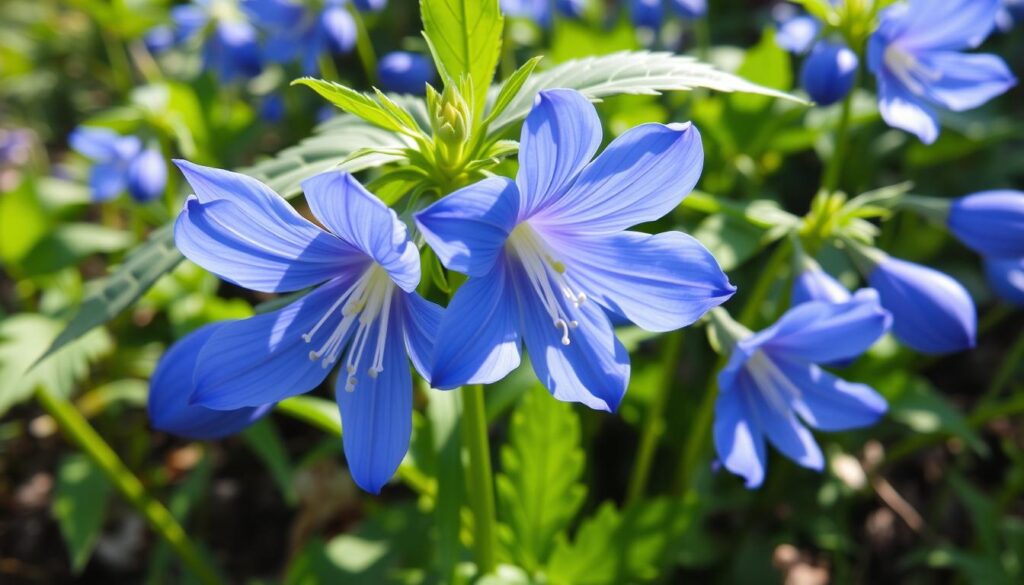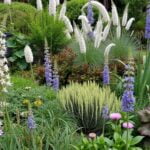Did you know that Platycodon grandiflorus, also known as the balloon flower, blooms for about 100 days a year? This perennial flower is loved by gardeners all over the world. Its unique buds and star-shaped flowers make it a favorite in gardens across the United States.
I find the balloon flower fascinating because it can grow in many climates. It’s originally from East Asia but now thrives in gardens from USDA hardiness zones 3 to 8. Its ability to adapt and bloom for a long time makes it popular with gardeners of all levels.
What makes Platycodon grandiflorus stand out is how versatile it is in gardens. You can use it to brighten up your borders or make a beautiful container display. With its bright violet-blue, white, and pink colors, it’s no surprise it won the Royal Horticultural Society Award of Garden Merit.
Key Takeaways
- Platycodon grandiflorus can bloom for up to 100 days annually
- It thrives in USDA hardiness zones 3 to 8
- The balloon flower comes in violet-blue, white, and pink varieties
- It has received the Royal Horticultural Society Award of Garden Merit
- Platycodon grandiflorus is adaptable to various garden designs
Introduction to Platycodon grandiflorus
I’m thrilled to introduce you to Platycodon grandiflorus, a beautiful plant for gardens. Known as the balloon flower, it’s loved by gardeners around the world. Its unique traits and easy care make it ideal for gardens that don’t need a lot of work.
Origin and Natural Habitat
Platycodon grandiflorus comes from East Asia’s diverse lands. It’s found in China, Korea, Japan, and the Russian Far East. This plant is tough and can grow in many climates, from USDA zones 3A to 9b.
Unique Characteristics of the Balloon Flower
The balloon flower’s name comes from its buds that look like balloons before they open. Its flowers are shaped like bells and can be purple or white. They bloom in July and August. This plant is amazing because it can survive temperatures as low as -40°C.
Popularity in Ornamental Gardens
Gardeners adore Platycodon grandiflorus for its beauty and easy care. It grows 12-30 inches tall and spreads about 20 inches. The Royal Horticultural Society has given some varieties top marks.
| Feature | Description |
|---|---|
| Height | 12-30 inches |
| Spacing | 20 inches |
| Sunlight | Full sun, partial shade in hot climates |
| Soil | Loamy, well-draining |
| Watering | Low requirements |
Botanical Description and Growth Habits
I’m always amazed by the unique traits of Platycodon grandiflorus, also known as the balloon flower. This plant grows 18-24 inches tall, ideal for gardens needing drought-tolerant flowers with color. Its buds swell like little balloons before opening into star-shaped blooms.
https://www.youtube.com/watch?v=548llnc3r4Y
From May to August, these perennials show off with blue, white, and purple flowers. Their blooming period is impressive, adding color to gardens for months. The plant has thick roots and dark green leaves, setting off the vibrant flowers beautifully.
Balloon flowers love full sun and moist, well-drained soil. They’re easy to grow but need the right conditions. Their stems are weak and might need staking in windy spots. Also, avoid planting them in wet soil to prevent root rot.
“Platycodon grandiflorus is a true gem in the world of drought-tolerant flowers, offering both resilience and beauty to any garden.”
This hardy perennial dies back in winter but comes back in late spring. It’s perfect for gardeners wanting low-maintenance plants with year-round color.
Varieties and Cultivars of Platycodon grandiflorus
Platycodon grandiflorus, also known as the balloon flower, brings a variety of colors and shapes to gardens. These heirloom varieties are perfect for adding whimsy to any garden. They are true cottage garden classics.
Common Color Variations
Balloon flowers have many beautiful colors. You can find them in:
- Blue
- White
- Pink
- Purple
In Korea, white balloon flowers are more common. They add a unique touch to gardens there.
Popular Cultivars and Their Features
Some balloon flower cultivars are well-known for their special traits:
| Cultivar | Height | Flower Size | Color |
|---|---|---|---|
| ‘Mariesii’ | 40-60 cm | 6-7 cm | Light purple with blue flush |
| ‘Fuji Blue’ | 60-100 cm | 6 cm | Bluish-purple |
| ‘Astra Pink’ | 25-30 cm | 7 cm | Pale pink |
| ‘Hakone White’ | 50-60 cm | 7-8 cm | Pure white, double flowers |
Rare and Unusual Varieties
For those looking for something unique, these balloon flower varieties are special:
- ‘Komachi’: Grows up to 1 meter tall with purple ‘balloons’ that never open
- ‘Misato Purple’: Bears large 9 cm violet flowers
- ‘Fairy Snow’: Petite 4 cm white blooms
These varieties offer endless possibilities for creating beautiful garden displays.
Whether you prefer the compact ‘Sentimental Blue’ or the tall ‘Komachi’, there’s a balloon flower for every garden style and preference.
Planting and Growing Platycodon grandiflorus
I adore growing Platycodon grandiflorus, also known as balloon flower, in my garden. This perennial flower species is a true gem, offering long-lasting blooms that never fail to impress. Native to East Asia, balloon flowers have found a special place in American gardens, thriving in USDA Hardiness Zones 3 to 8.

When planting balloon flowers, I choose a spot with full sun to partial shade. These hardy plants prefer well-drained, loamy soil with a pH between 5.5 and 7.5. Adding organic matter to the soil helps promote healthy growth and vibrant blooms.
Platycodon grandiflorus is versatile. I’ve grown them in borders, rock gardens, and even containers. Remember, when planting in pots, choose a deep container to accommodate their long taproot – at least 10-12 inches deep and 2 inches wider than the mature plant.
Watering is crucial for establishing balloon flowers. I aim for about an inch of water per week, adjusting based on rainfall. Once established, these plants are quite drought-tolerant, making them perfect for water-wise gardening in Texas and other dry regions.
For those interested in different varieties, here are some popular cultivars:
- ‘Astra Blue’: Compact at 8 inches tall and wide
- ‘Hakone Blue’: Taller at 24 inches with a spread of 18 inches
- ‘Sentimental Blue’: Mid-size at 12 inches tall and 18 inches wide
With proper care, these perennial flower species will reward you with stunning, long-lasting blooms year after year. Their low-maintenance nature and beautiful balloon-shaped buds make them a favorite in my garden, and I’m sure they’ll become a staple in yours too!
Perennial Flower Species: Care and Maintenance
Perennial flowers are a great choice for easy gardens. These plants live more than two years and need little care once they start. Let’s see how to keep your perennials looking great.
Watering Requirements
Most perennials can handle drought, especially after their first year. I water them about one inch a week. To save water, I put a 2-3 inch layer of mulch around them. This keeps the soil cool and cuts down on weeds.
Fertilization Needs
Perennials don’t need much food. I use a 10-10-10 or 5-10-5 fertilizer only when needed. Too much can cause weak growth and fewer flowers. For plants that need more, I fertilize in May and July.
Pruning and Deadheading
Pruning is key to keeping perennials looking good. In March, I cut back grasses. In June, I trim tall plants to stop them from flopping. Removing dead flowers makes them bloom more and keeps their shape.
With the right care, perennials like yarrow, asters, and daylilies can last for years. These plants are ideal for beautiful, low-care gardens that keep blooming season after season.
Landscape Design with Balloon Flowers
I love using balloon flowers in my garden designs. They bring whimsy and seasonal color to any landscape. Platycodon grandiflorus is great for low borders, rock gardens, and containers.
Balloon flowers grow up to 24 inches tall, making them perfect for large areas. They look stunning when planted together on slopes or in Asian-style gardens. For small spaces, the dwarf varieties grow only 8 inches tall.
These flowers bloom from mid-summer to early fall. They add color to gardens during a long season. ‘Sentimental Blue’ blooms first in mid-July, and white varieties bloom last, in mid-August.
Consider the three main colors of balloon flowers: blue, pink, and white. Mixing them with other perennials creates a vibrant look. They are easy to care for, thriving in USDA zones 3-8.
- Perfect for borders and rock gardens
- Ideal for container planting
- Great for slopes and mass plantings
- Adds charm to Asian-inspired gardens
Balloon flowers do best in full sun but can also grow in partial shade. This makes them versatile for any landscape, adding color where you need it most.
Companion Plants for Platycodon grandiflorus
I love pairing balloon flowers with other perennials to make beautiful garden scenes. These plants are great for mixing colors and creating balanced looks.
Complementary Perennials
When picking plants for Platycodon grandiflorus, I look for ones that like the same conditions. Some top choices are:
- Echinacea (Coneflower)
- Coreopsis (Tickseed)
- Salvia (Sage)
- Hemerocallis (Daylilies)
- Hosta
Color Combinations
Balloon flowers have soft colors like blue, white, and pink. I pair them with other colors to make striking schemes. For example:
| Balloon Flower Color | Complementary Colors |
|---|---|
| Blue | Yellow, Orange, White |
| White | Purple, Pink, Red |
| Pink | Silver, Lavender, Deep Purple |
Creating Balanced Garden Compositions
To make a beautiful garden, I think about plant heights, textures, and when they bloom. Medium balloon flowers (1-2.5 feet tall) are great under tall shrubs like viburnum or hydrangea. Shorter varieties like ‘Sentimental Blue’ (8 inches) work well in front, and taller ones like ‘Shell Pink’ (2 feet) in the back.
By mixing balloon flowers with other perennials, I make gardens that look good all season.
Cultural Significance and Symbolism

I find the cultural heritage of plants fascinating, and Platycodon grandiflorus is a great example. Known as the balloon flower or kikyō in Japan, it’s a key part of East Asian traditions. It’s one of the Seven Autumn Flowers in Japan, symbolizing the beauty and fleeting nature of autumn.
In Japan, the balloon flower’s look has inspired family crests called kamon. The Toki Kikyō and Ōta Kikyō are beautiful examples of these designs. These crests link modern families to their past, just like how cottage garden classics connect us to gardening traditions.
In Korea, this flower is called doraji. It’s more than a pretty plant; it’s a cultural symbol. The folk song “Doraji taryeong” celebrates this flower. It’s amazing how a simple plant can bring people together across borders – the song is loved by Koreans in North and South Korea, and in ethnic Korean communities in China and Japan.
“The balloon flower sings a song of unity, bridging cultures and generations with its delicate petals.”
Like many cottage garden classics, Platycodon grandiflorus has deep meaning. It shows us that beauty can be both short-lived and lasting, like the seasons it marks. In our gardens, these plants do more than just look good. They connect us to a rich history of cultural stories and shared human experiences.
Medicinal and Culinary Uses
I’ve learned that Platycodon grandiflorus, a stunning perennial flower, is more than just for looks. In Korea, its root, called doraji, is a key ingredient in dishes like bibimbap. It’s also used in desserts, teas, and even infused liquors.
The roots of Platycodon grandiflorus have amazing health benefits. They help fight inflammation and lower cholesterol. In traditional Chinese medicine, it’s a go-to for coughs and to help clear mucus. Korean healers use it to treat bronchitis and asthma.
While looking into other plants with multiple uses, I found nasturtiums add a spicy taste to salads. Pineapple sage is great for fish rubs and teas because of its scent. Lavender, a low-care perennial, is calming and can be used as a natural antiseptic. These plants show how perennials can improve our gardens and health.


